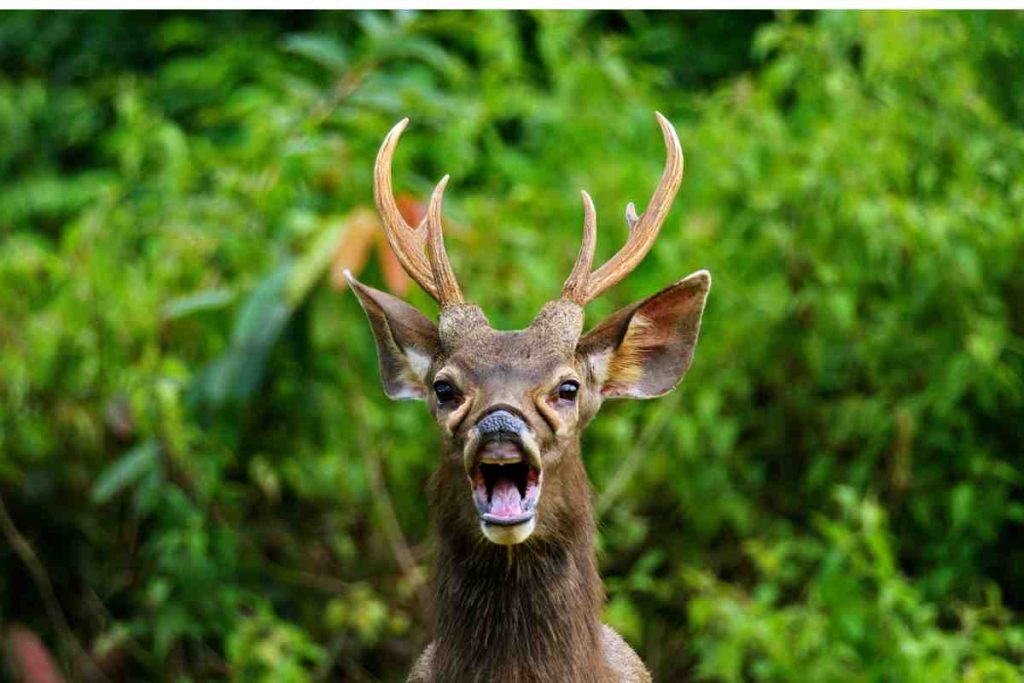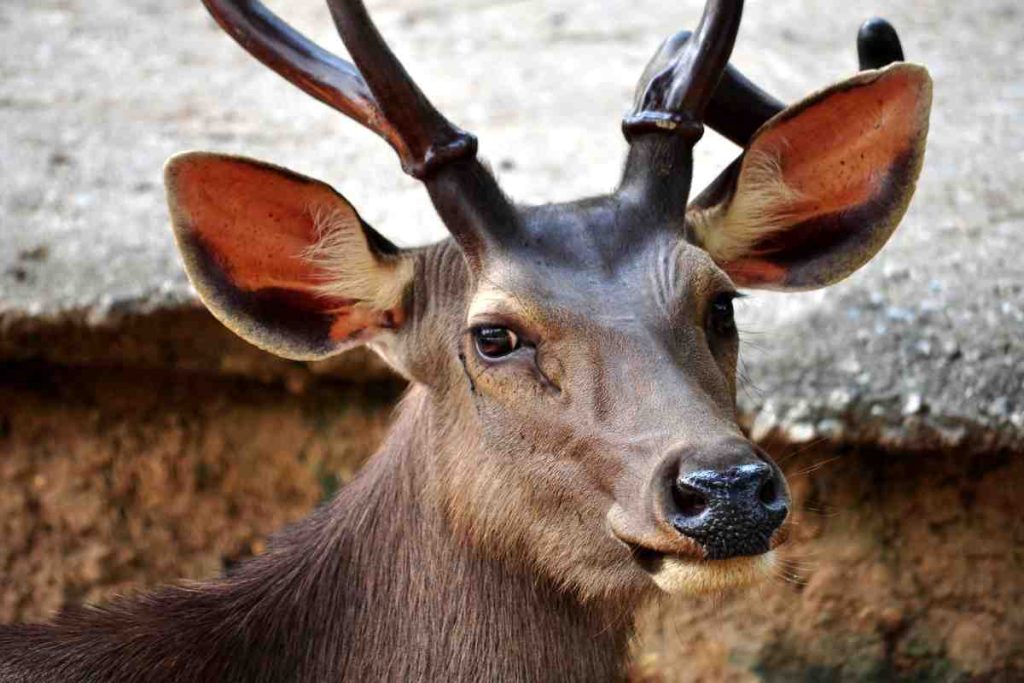The Sambar deer, or Rusa unicolor, is a large species native to South and Southeast Asia. They are known for their remarkable adaptability and can find in many habitats, from dense forests to grasslands and even marshy areas. This adaptability has allowed them to thrive in various environments and make them one of the most successful deer species in the region.
A Closer Look at the Sambar Deer: Physical Characteristics and Distribution
Sambar deer are easily recognizable due to their large size and distinctive appearance. They are the largest deer species in Asia, with males reaching heights of up to 150 centimeters at the shoulder and weighing up to 600 kilograms. Females are slightly smaller but still impressive in size.
Their coat is usually dark brown or gray, with a lighter underbelly. They have a shaggy mane on their neck and a short tail. One of their most striking features is their large, branching antlers, which can grow up to 110 centimeters in length.
Sambar deer have a wide distribution across South and Southeast Asia. They can be found in India, Sri Lanka, Nepal, Bhutan, Myanmar, Thailand, Malaysia, and Indonesia. They have also been introduced to other parts of the world, including Australia and New Zealand.
Masters of Camouflage: How Sambar Deer Blend Perfectly with Their Surroundings

One of the reasons for the Sambar deer’s success is their incredible ability to blend in with their surroundings. They have evolved natural camouflage that keeps them hidden from predators and threats.
Their coat coloration helps them blend into the dense vegetation of forests and grasslands. The dark brown or gray color provides excellent camouflage against the shadows and dappled light of the forest floor. In addition, their coat has a mottled pattern that resembles the dappled sunlight filtering through the leaves, making them almost invisible to predators.
Sambar deer also have a keen sense of hearing and smell, which helps them detect potential threats before they are spotted. They are known for their cautious and alert behavior, often freezing in place when they sense danger, further enhancing their camouflage.
The Art of Survival: How Sambar Deer Evade Predators and Thrive in Challenging Environments
Sambar deer have developed various strategies to evade predators and thrive in challenging environments. One of their primary defense mechanisms is their ability to remain motionless and blend into their surroundings, allowing them to go unnoticed by predators such as tigers, leopards, and wild dogs.
In addition to their camouflage, Sambar deer are excellent swimmers and can escape predators by taking refuge in water bodies such as rivers and lakes. They are agile runners and can reach up to 30 miles per hour when necessary.
Sambar deer are also known for their adaptability in challenging environments. They can survive in areas with limited food resources by browsing various plants, including grasses, leaves, fruits, and even bark. This versatility allows them to thrive in habitats where other herbivores may struggle to find enough food.
Feeding Habits: Sambar Deer’s Versatile Diet and Foraging Techniques

Sambar deer have a versatile diet and can adapt to different food sources depending on the availability in their habitat. They are primarily herbivores and feed on a wide variety of plants.
In forested areas, Sambar deer browse on leaves, twigs, and fruits of various tree species. They are known to feed on bamboo shoots, which provide them with essential nutrients. In grasslands, they graze on grasses and other low-lying vegetation.
Sambar deer have a unique foraging technique known as “barking.” They use their lower incisors to strip the bark of trees, exposing the inner layers they consume. This behavior is prevalent during the dry season when food resources may be scarce.
Social Structure: Understanding the Complex Relationships Among Sambar Deer
Sambar deer are social animals and live in herds of females and their offspring. The herd size can vary depending on the availability of resources in their habitat.
The herd has a complex social structure with dominant individuals and hierarchies. Males establish territories and compete for access to females during the breeding season. They engage in displays of dominance, such as antler wrestling and vocalizations, to establish their rank within the herd.
Females form strong bonds with their offspring and often stay together in small groups. They are responsible for raising and protecting their young, teaching them essential survival skills such as foraging and avoiding predators.
Reproduction and Parenting: The Unique Strategies of Sambar Deer

Sambar deer have unique reproductive strategies contribute to their survival and population growth. Breeding usually occurs during the monsoon season when food resources are abundant.
Males compete for access to females by engaging in fierce battles using their antlers. The “harem master,” or dominant male, mates with multiple females within his territory.
After a gestation period of around 8 months, females give birth to a single fawn. The mother hides the fawn in dense vegetation for the first few weeks of its life to protect it from predators. She periodically returns to nurse the fawn until old enough to join the herd.
Threats and Conservation: Challenges Faced by Sambar Deer and Efforts to Protect Them
Sambar deer face various threats in their natural habitats, including habitat loss due to deforestation and human encroachment. They are also hunted for their meat, antlers, and other body parts, highly valued in traditional medicine.
Conservation efforts are in place to protect Sambar deer populations and their habitats. These include establishing protected areas, such as national parks and wildlife sanctuaries, where hunting is prohibited. Conservation organizations also work to raise awareness about the importance of preserving these iconic deer species.
Sambar Deer in Mythology and Culture: Symbolism and Significance in Various Societies

Sambar deer hold significant symbolism and cultural importance in various societies across their range. In Hindu mythology, they are associated with the god of love, Kamadeva, and are considered sacred animals. They are also depicted in ancient Indian art and sculptures.
In Sri Lanka, Sambar deer are known as “Rathu Hora” and symbolize strength and power. They are often depicted in traditional art forms such as paintings and wood carvings.
In Southeast Asia, Sambar deer are revered for their beauty and grace. They are often featured in traditional dances and ceremonies, symbolizing harmony with nature.
Celebrating the Resilience and Beauty of Sambar Deer in the Natural World
The Sambar deer’s remarkable adaptability, survival skills, and beauty make them a truly remarkable species in the natural world. Their ability to blend into their surroundings, evade predators, and thrive in challenging environments is a testament to their resilience.
As we appreciate the beauty of Sambar deer, it is essential to recognize the threats they face and the need for conservation efforts to protect their populations. By preserving their habitats and raising awareness about their importance, we can ensure that future generations can continue to admire these incredible creatures in the wild.
More Sources: Exploring the Vibrant World of Tropical Animals

Leave a Reply